It's An RGB Disco: The GIGABYTE X299 Gaming 7 Pro Motherboard, Reviewed
by Joe Shields on January 26, 2018 8:00 AM EST- Posted in
- Motherboards
- Gaming
- Intel
- Gigabyte
- AORUS
- RGB
- X299
- Basin Falls
- Skylake-X
- Gaming 7 Pro
X299 Gaming 7 Pro Visual Inspection
If you wanted LEDs, this motherboard has them. In spades. Not only in the usual places, such as the chipset heatsink, but the rear-IO panel, the rear-IO shroud, in-between each of the DRAM slots, and for good measure, on the PCIe slots as well.
At first glance, the X299 Gaming 7 Pro (hereafter, G7P) looks a bit of busy of a motherboard without the light show of RGB LEDs. The memory and PCIe slots all use slot reinforcement and have RGB lighting on them creating a contrast to the black board. In addition to those locations, both shrouds on the left and the chipset heatsink also have RGB LEDs. They are almost all over this board.
The power delivery heatsink up top has small slits cut into it to try and improve surface area, although this is not much of an overall change. There is a heat pipe which routes around the left memory slots and under the back panel shroud to connect to a second, hidden heatsink. This should do a better job than X299 boards with a single heatsink, especially with the included fan (pictured later) blowing on that secondary heatsink. Also with heatsinks are the three M.2 slots, which is something we find only on premium boards.
Starting with fan headers, the X299 Gaming 7 Pro is equipped with eight 4-pin headers. At the top, there are three headers, Sys Fan 2, CPU, and CPU Opt. The right side of the board is Sys Fan 6/Pump and Sys Fan 5. On the bottom of the board between the debug LED and USB headers are two more system fan headers, and finally, above the top PCIe slot to the left of the memory slots is Sys Fan 1. All headers offer both PWM and voltage control. Gigabyte's Smart Fan 5 software in the BIOS or within the App Center are able to use preset profiles or custom fan curves.
The power delivery on the Gaming 7 Pro is a 12-phase (6 doubled) using 60A power stages. Controlling these is the Intersil ISL69138 6+1 phase, true digital PWM. The additional phase is used for VCCSA. The power stages use an ISL99227 Smart Power stage rated to 60A while the phase doubling duty is handled by six ISL6617 found on the back of the motherboard. Delivering power to the CPU are two 8-pin EPS 12V plugs (only one is required for regular use).
The eight DRAM slots on the AORUS X299 Gaming 7 Pro are unlike others we have seen in the past. They do come with slot reinforcement for additional support for those 'heavy' DIMMs, but that isn't the unique part. What is unique are the RGB LEDs and lighting between them illuminating the sticks in the slots. Using this method, it allows GIGABYTE to have a regular positioning of the memory slots (which isn't always the case, making some boards unsightly). Supported memory speeds are up to DDR4-4400, with a maximum capacity at the typical 128GB for an X299 motherboard. Technically the board also supports RDIMMs for 512GB capacity, however none of the CPUs for this motherboard support RDIMMs with ECC. Unlike most boards we have reviewed lately, there are two locking mechanisms for the DRAM modules. After using plenty of boards with only one latch, two latches feels a bit clunky comparatively, but allows for a firm insertion.
The right-hand side of the board has 8 SATA ports (on the left of the picture below). The middle of this area has a USB 3.1 (10 Gbps) port, a USB 3.0 header, a couple of fan headers, and the 24-pin ATX plug.
This image displays the eight SATA ports supporting RAID 0, 1, 5, and 10. The board does not come with a U.2 connector.
Across the bottom of the motherboard, there are several IO options and buttons. From left to right we see:
- Front Panel Audio
- RGBW 5-pin
- RGB Voltage Selection Jumper
- TPM Header
- ECO/OC/RESET/POWER buttons
- 2 x Front Panel USB 2.0/1.1 Headers
- 2 x Fan Headers
- Debug LED
- USB 3.0 Header
- Front Panel Header
For PCIe, the X299 Gaming 7 Pro has a total of five full-length PCIe slots all reinforced to help support heavy video cards. In addition to the slot reinforcement, each PCIe slot has RGB LEDs surrounding the slot and is another area controlled by the RGB Fusion software. There are no physical x4 or x1 slots, allowing all full-length cards. The primary GPU slots, from top to bottom, are slots one, three, and five, which have a maximum bandwidth of x16/x16/x8 and support both 3-Way SLI and Crossfire configurations. The other two slots are a maximum x4 and are connected through the chipset.
Audio duties are handled by the Realtek ALC 1220 audio codec with an ESS Sabre reference DAC, WIMA and Nichicon audiophile grade capacitors, as well as independenent analog power to delive clean power to the audio components.
Below is a simplified list of how the PCIe slots will work with each family of CPUs (talking PCIe lanes) when multiple cards are used (the "@" symbol is used to show slot preference for the configuration):
| AORUS X299 Gaming 7 Pro CPU PCIe Layout | ||||||
| 44-Lane 1/2-Way |
44-Lane 3-Way |
28-Lane 1/2-Way |
28-Lane 3-Way |
16-Lane 1-Way |
16-Lane 2-Way |
|
| PCIe 1 | @x16 | x16 | @x16 | x8 | @x8 | @x8 |
| PCIe 3 | @x16 | x16 | @x8 | x8 | - | @x4 |
| PCIe 5 | x8 | x8 | - | x8 | - | - |
| SLI | Yes | Yes | Yes | Yes | - | No |
| Crossfire | Yes | Yes | Yes | Yes | - | Yes |
The back panel IO consists of:
- PS/2 Mouse/Keyboard Port
- 4 x USB 3.1 5 Gbps Ports
- 1 x USB 3.1 10 Gbps Type-C Port
- 4 x USB 3.1 10 Gbps Type-A Ports
- 2 RJ-45 Ports
- Wi-Fi/BT Module
- 5-plug Gold-plated Audio Stack w/ SPDIF
If you look closely we are able to see the small fan attached to the secondary VRM heatsink just above the USB Type-C port as well.
In the Box
- Driver Disk / User's Manual / Installation Guide / A lot of Stickers
- 2-Way Hard SLI Bridge
- Wi-Fi Antenna
- 4 x SATA Cables
- 2 x Temperature Probes
- RGB LED Extensions
- Back Panel IO Plate
- Velcro Straps
For a gaming motherboard, aside from some gimmick addition, this is about what we would expect in the box.


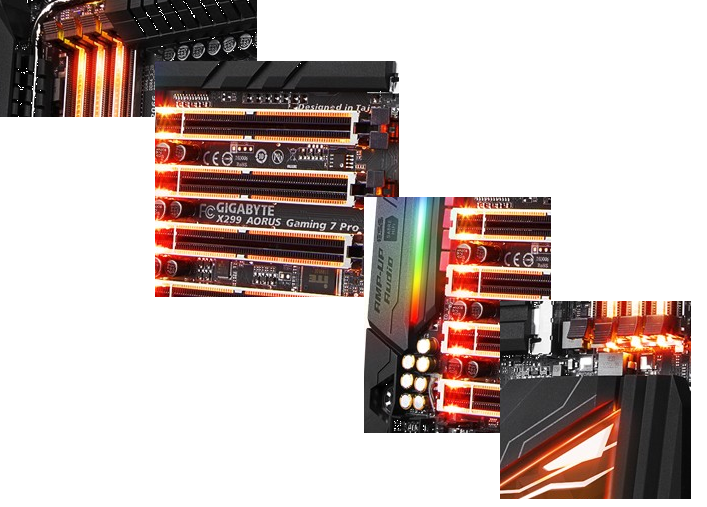

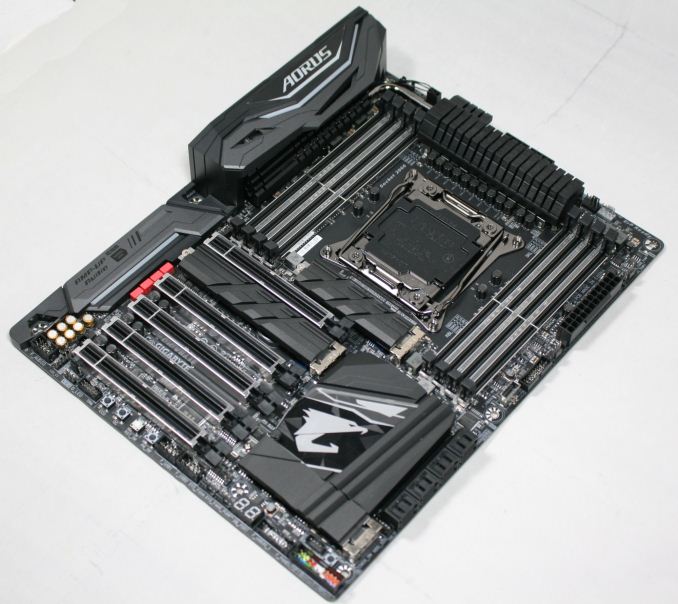
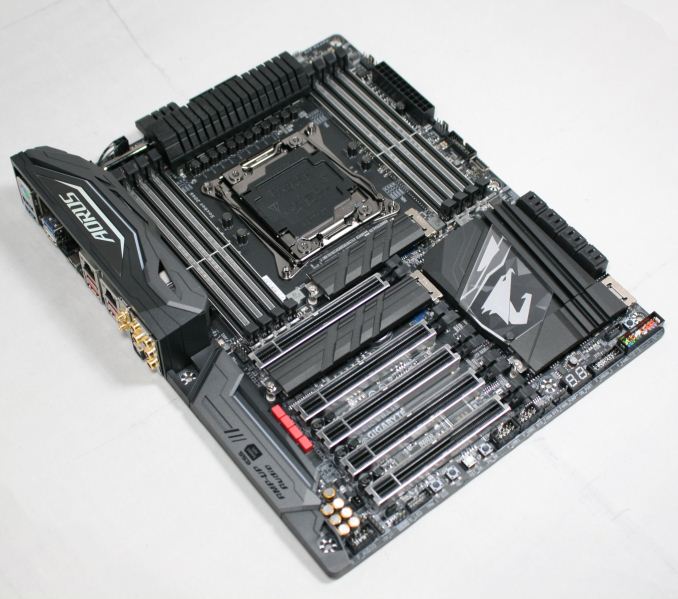

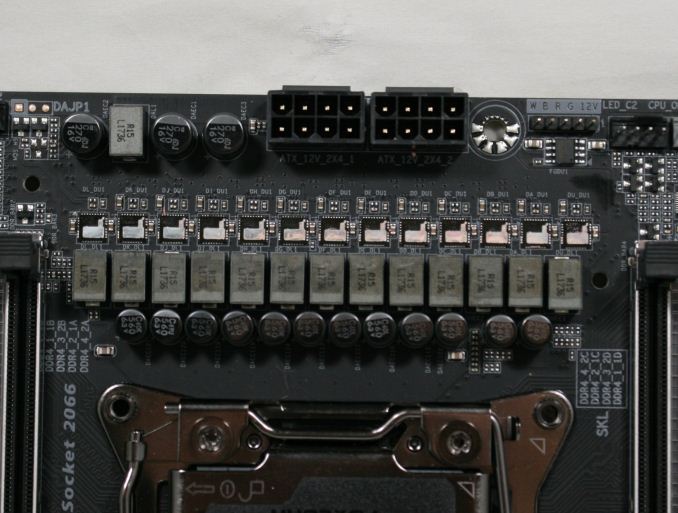
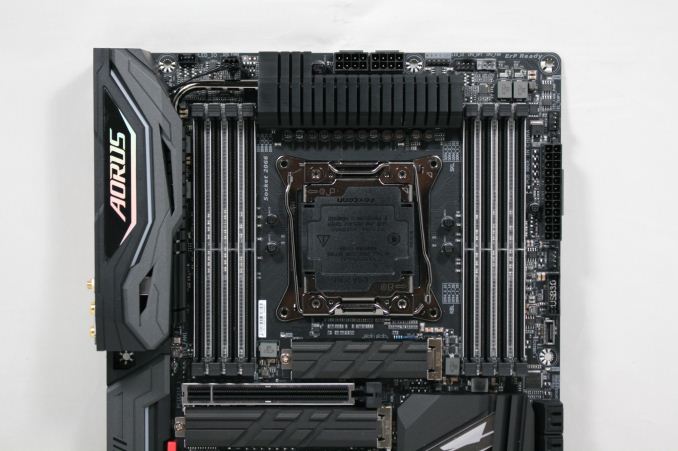



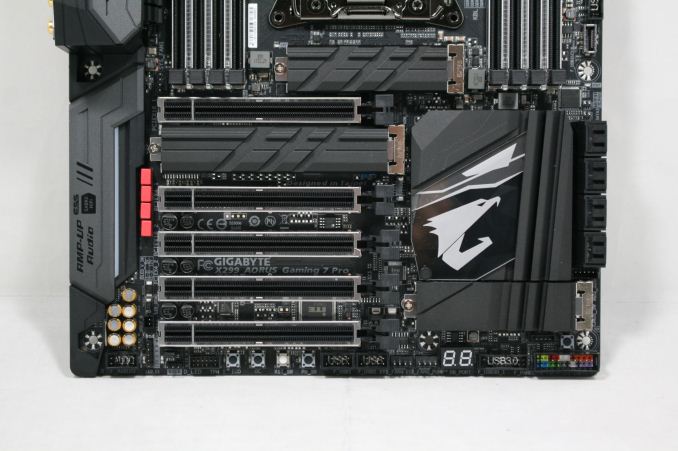
















29 Comments
View All Comments
Lord of the Bored - Saturday, January 27, 2018 - link
You misunderstand. It isn't about whether it inconveniences or affects them in any way. It is about needing a reason to bitch about something.WinterCharm - Thursday, February 1, 2018 - link
> adds next to no priceCitation needed.
timecop1818 - Friday, January 26, 2018 - link
Fucking killer NIC. That shit cannot die soon enough. Why even waste space on that, even 10GbE and an intel 1GbE would make more sense.I was looking at Gigabyte boards a bit ago and anything with decent features was ruined by KillerShit, so I switched to ASUS for PRO/A series without dumb shit thrown in.
Ian Cutress - Friday, January 26, 2018 - link
I'll forward your concerns to Rivet. Anything specific you don't like about Killer, especially the latest hardware?PeachNCream - Friday, January 26, 2018 - link
Hey Ian, since Joe has the hardware already, is it possible for Anandtech to do some more in-depth benchmarking of the Killer ethernet and wireless cards on this motherboard? Internet gaming tests under real world conditions might help us put Killer's value proposition into perspective.oRAirwolf - Friday, January 26, 2018 - link
I agree with peachncream. Killer has made some absolutely awful networking products in the past that were further crippled by their horrendous drivers and unnecessary software. It has left a bad taste in everybody's mouth and very few if any PC enthusiasts are happy to see their products in a motherboard. From what I see online, it seems as though most people either don't install their software or uninstall it if it comes pre-packaged. Rather than forwarding complaints to deaf ears at Rivet Networks, it would make a lot more sense to do some very detailed benchmarking, including Aquantia's new chipsets, showing the pros and cons of each solution and the impact they have on things like latency, CPU usage, bandwidth, and game perfomance. I am especially interested to see some benchmarks pitting the new Aquantia chipsets against Intel's 10gbe offerings like the X540, X550, and X710 with RJ45 ports.Notmyusualid - Saturday, January 27, 2018 - link
I disagree.There is nothing wrong with their hardware in my opinion.
Just install the basic driver, or the Qualcomm driver, and you will be unable to tell the difference from your typical Intel NIC, on any consumer device. You don't have to install their network suite.
Meanwhile I've had no end of trouble with my X540 10Gb/s NICs. So much so - I returned it for replacement. And whilst I've not been home yet to try the replacement, I'm not confident of good results.
HobartTas - Saturday, January 27, 2018 - link
Hello Ian from Australia! I signed up just now to reply to your question to timecop1818 and I'll give you my impression of previous killer standalone $200 network cards and their embedded chipset Ethernet products. Basically the product is of no real benefit over any other networking product and in one specific case I'll mention later on completely useless. It supposedly originally prioritized gaming packets within the machine over other traffic which might have been of some use at a lan event where you bring your own machine but then you probably wouldn't be using your machine for anything else at the time so gaming traffic was probably all that was going out over the network anyway, so no benefit there and these days most people do their gaming over the internet anyway.When I only had 8/1 Adsl1 and (max speed) 12/1 Adsl2 available for internet the same would apply as you couldn't do anything else because even if you downloaded other stuff at say 50% of Adsl download speed the 50 byte acknowledgement packets going out to request the next packet be sent down to you would blow out pings from 40-60 to 200 as the upload speed of 1 Mbit was just way too slow and congestion occurred (think goat track compared to 8 lane freeway) so again I'm left with just gaming traffic only because I couldn't do anything else so no benefit over any other ethernet chipset again.
Now that I'm on fibre at 100/40 and I have a truckload of bandwidth I can be gaming and also downloading Nvidia drivers at 11 MB's and gaming pings only slightly rise from 22 to 26 so killer is not needed at all again as any other Ethernet chipset will do just fine.
Software: According to their website https://www.killernetworking.com/driver-downloads it's windows only and nothing else. I have a 4930K and a Gigabyte X79S-UP5-WIFI board which has both Intel and Realtek ethernet connectors on it and that's my Windows 7 gaming machine. My other identical board has an I7-3820 cpu and I'm testing Solaris 11.3 as a ZFS NAS and for whatever reason the Intel Ethernet connector came up as "mis-configured" and I couldn't work out why that was so I plugged in the network cable into the other Realtek connector and off I went. If I had a killer ethernet instead of Realtek I'd either have to figure out the Intel mis-configuration or get another Gbe network card (probably Intel) and plug it in as Killer have no Solaris, BSD or Linux drivers which is pretty useless of them.
For those people who find that Gbe isn't fast enough and are looking at 10Gbe that's not expensive the speed increase stated on their webpage https://www.killernetworking.com/products/killer-e... going from 940 Mbs to 1102 Mbs may as well be totally insignificant as all it is is just re-inventing the existing wheel. I picked up about a year ago very cheap (approx USD$ 50) Mellanox QDR infiniband cards when they deprecated the technology and these cards are 40 Gbs Infiniband/10 Gbs Ethernet capable so if this chipset actually was 100 Base T (or even 50 or 25) then and only then would I possibly be interested as probably would other people as well.
No one wants to muck around with a "control center" for Ethernet as I just want the network to "just work" when I plug the cable in and I'm happy with some crappy no-name no-brand software TCP/IP stack that works reliably even if it only goes at say 90% of maximum speed. I hope its not anywhere near as useless as the Nvidia Firewall software I once had the misfortune to install as it completely stuffed up my network port and rendered it non-functional which still didn't work even after I uninstalled the software and I had to reformat the hard drive and re-install windows to fix that problem.
Anyway that's everything that's CURRENTLY wrong with this product and nothing that's right with it as I have explained in detail above, If they posted drivers for all the other OS's then it might get half way to being merely usable. Feel free to pass my entire comment over to Rivet and I look forward to any reply to any part of my comments posted back here but I'm not holding my breath in anticipation of that.
Cheers
Strunf - Saturday, January 27, 2018 - link
They are the answer to a non existant problem... or better the real problem is the Internet speeds people have and there's nothing Killer can do about it. People that have slow internet already turn off any sharing software when they play games and those that have a fast one don't care cause they have more than enough, those in-between will just turn off any bandwidth hungry apps just for a piece of mind.On bittorrent if you share at a very slow speeds, as would be the case if you play and torrent at the same time on a slow connection no one will connect to you or kick you if the speeds are too low, no one wants to spend time and resources on a connection that is as fast as a snail.
Tamz_msc - Friday, January 26, 2018 - link
From what I have read recently Killer LAN is mostly fine as long as you don't install their software. Linux support might be spotty though.